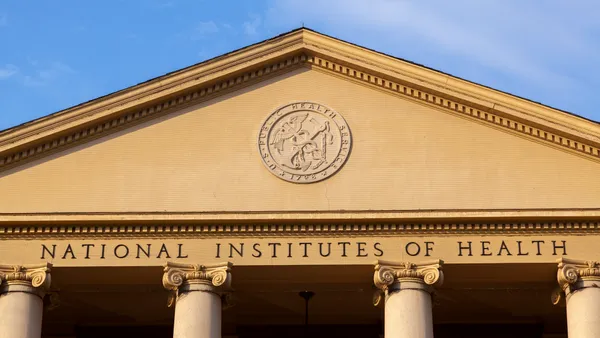PharmaVOICE Container or labeling of which, without authorization, bears the trademark, trade name, or other identifying mark, imprint, or device, or any likeness thereof, of a drug manufacturer, pro cessor, packer, or distributor other than the per son or persons who in fact manufactured, pro cessed, packed, or distributed such drug and which thereby falsely purports or is represent ed to be the product of, or to have been packed or distributed by, such other drug manufactur er, processor, packer, or distributor.” The International Federation of Pharmaceu tical Manufacturers Association estimates that 2% of the $327 billion of drugs sold annually are counterfeit, representing a market value of $6 billion. The World Health Organization estimates that between 5% and 8% of the world’s supply of branded medicines are coun terfeit; up to 40% in some developing nations. T oday, drug counterfeiting is esti mated to cost the industry $21 bil lion annually. It is believed that availability of drugs through new Internet pharmacies has helped to accelerate the drug counterfeiting problem — a problem in need of immediate solutions. “We would like to think that the global pharmacy supply chain is safe, but intercoun try, black market, and thirdparty sales are a relatively new problem to be addressed by reg ulatory authorities,” says Donald E. Morel Jr., Ph.D., CEO and president of West Pharma ceutical Services Inc. According to Dr. Morel, one of the key considerations for manufacturers is the selec tion of customized packaging and packaging components for injectable drugs. “Where once standard packaging compo nents readily met the needs for packaging injectable drugs, those standard components could now increase the vulnerability of the drug to counterfeiting activities,” he says. “It is a question of finding ways to identify the drug as truly genuine. Once vial selection and labeling have been determined, packaging engineers can then turn their attention to choosing an effec tive closure system. New technologies have THE PACKAGE DEAL been developed for unique closure systems, affording opportunities for drug manufacturers to improve the decoration, identification, and differentiation of their injectable drug.” The Scourge of DRUG COUNTERFEITING While drug counterfeiting has become a serious threat to the pharmaceutical industry worldwide, it is most prevalent in developing countries, where regulatory oversight is limit ed. According to Dr. Morel, incidences of drug counterfeiting have not only inhibited a patient’s recovery, but in some instances have resulted in fatalities. Counterfeiting exposes manufacturers to an increased risk of litigation and product recalls, undermines public confi dence in the pharmaceutical industry, and cre ates a range of business problems for manufac tures, including their ability to gauge market activity of their products. The Food, Drug, and Cosmetic Act defines a counterfeit drug as “a drug which, or the con Protecting Big Pharma Against Drug Counterfeiting In today’s dynamic drug market, DRUG COUNTERFEITING has grown into a considerable economic and public health issue and is RAPIDLY BECOMING PROBLEMATIC for pharmaceutical manufacturers. IN AN EXCLUSIVE INTERVIEW WITH PHARMAVOICE, DONALD E. MOREL JR., PH.D., CEO AND PRESIDENT OF WEST PHARMACEUTICAL SERVICES INC.,ADDRESSES THE GROWING PROBLEM OF DRUG COUNTERFEITING. PHOTOGRAPHY BY ED WHEELER EDWHEELER.COM VIEW on counterfeiting PharmaVOICE “The incidence of counterfeiting varies widely from the developed Western countries, where the best estimates of incidence are about 2% to 4%, to developing countries, where the incidence is much greater,” Dr. Morel says. “In some developing countries in Asia, counterfeit ing can be as high as 40% to 50%. In sub Sahara Africa, it can be as high as 70% to 80%. “The biggest risk, in my mind, is in infec tious disease, in places such as subSahara Africa, where people are forced to use black market drugs,” Dr. Morel says. The incidences of counterfeiting are increasing, according to Dr. Morel. In the U.S. this year alone, several companies have fallen victim to drug counterfeiting. According to an Associated Press report in May 2002, coun terfeit drug products found in the U.S., in the first five months of 2002, include: Bayer AG’s Gamimune N, used to treat patients with weakened immune systems; Eli Lilly & Co.’s Zyprexa, for schizophrenia; Amgen Inc.’s Epogen, an anemia drug; GlaxoSmithKline’s to an increased risk of litigation and product recalls, undermines public confidence in the pharmaceutical industry, and creates a range of business problems for manufactures, including their ability to gauge market activity of their products. Dr. Donald E. Morel Jr. VIEW on counterfeiting PharmaVOICE Combivir, an HIV drug; and Serono SA’s Serostim, for the treatment of AIDS. “It is certain that pharmaceutical compa nies will continue to face the issue of drug counterfeiting and it has become necessary for manufacturers to plan and implement proce dures that will proactively fight drug counter feiting,” he says. According to Dr. Morel, there are several ways counterfeit drugs make it to market. “One way counterfeiting can occur is when counterfeiters gain access to the primary pack aging components and put water or some other compound into the vial,” he says. “Another is when counterfeiters try to duplicate the pack aging, and again, put water or sugar water into the vial. A third tactic is when counterfeiters gain access to legitimate drugs, open the pack ages, and compromise the strength of the drug by diluting it. They then put the drug into other packages and sell 10 vials of the drug, when a single original vial was used to make those 10.” Detection and PREVENTION Pharmaceutical manufacturers and com ponent manufacturers are working closely to develop proprietary systems that will coun teract counterfeiting crimes. According to Dr. Morel, typically the closure system used for injectable drug vials includes a plastic button assembled with an aluminum shell and then placed over a rubber stopper. Although the button and the aluminum shell often are coordinated in readily identifiable colors, there has been little attempt to apply additional differentiation or identification to the closure system. “To remove the incidence of counterfeiting, companies are considering new molding, embossing, and printing technologies,” he says. “For example, a system of vial closures that offers customers plastic buttons without the raised ring in the top center portion of the plas tic button. The result is an unobstructed top surface that is suitable for printing or emboss ing text and graphics across the diameter of the button. These buttons can be used in conjunc tion with an aluminum shell, which also can be printed and embossed with text and graphics. This system allows a manufacturer to label the drug vial closure with a company brand, logo, or graphic using printing or embossing. This system, and those like it, helps endusers identify genuine products at the point of admin istration, while at the same time making the possibility of coun terfeiting extremely expensive, and extremely difficult.” ADDED SAFETY at the Point of Use Federal regulations may require products to have instruc tions available at the point of use. Pointofuse instructions can improve compliance with dosing regimens and help to reduce the risk associated with storage and handling errors and improper administration and reconstitution. “By printing the instruc tions for dosage, product strength, and handling directly on buttons and seals, the instructions remain with the vial until the drug is actually administered,” Dr. Morel says. “Instructions printed on the seal can be read even after the but ton is removed. The printing also can identify special products, such as clinical trial samples, validation samples, and media fills. By select ing a clear plastic button with printing on the underlying seal, manufacturers can provide caregivers an opportunity to read the instruc tions before removing the protective button. This compliance feature helps provide addi tional protection for the healthcare profession al and patient.” To optimize product development process es, pharmaceutical companies need to be aware of new packaging technology and work side byside with their supply partners. “These partners have the knowledge and experience to solve specific drug packaging challenges and can help them prevent and deter counterfeiting nationally or worldwide,” Dr. Morel says. “There will be growing use of anticounterfeiting measures as we go forward, especially for some of the newer, very high value drugs,” he says. “The drugs that coun terfeiters go after are biotech type drugs or very sophisticated anticancer, antiviral, or antibiotic drugs. For the counterfeiters, it’s a matter of fundamental economics. It costs them a couple of cents to try and make a knockoff package for a drug that costs $500 a dose, which they can then sell for $250; they will do this instead of counterfeiting an antibi otic that costs $10 a vial. “Counterfeiters understand economics, and they use the health demand for a product against the society that needs the drug,” Dr. Morel says. “These are smart people who under stand for a relatively small investment they can sell a counterfeit drug for 50% of the price of the actual drug and make a lot of money.” F PharmaVoice welcomes comments about this article. Email us at [email protected]. for manufacturers to plan and implement procedures that will proactively fight drug counterfeiting.
An article from









